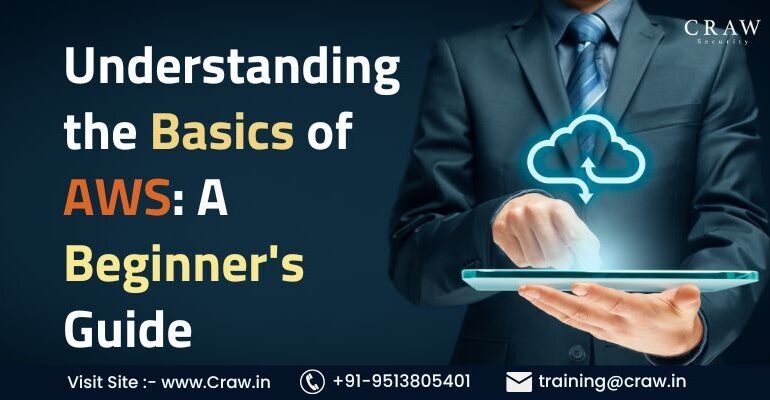Understanding the Basics of AWS: A Beginner’s Guide

Understanding the Basics of AWS: A Beginner’s Guide
The acronym AWS stands for Amazon Web Services, which leads in the current market in Platform as a Service (PaaS) and Infrastructure as a Service (IaaS) and provides a variety of remote cloud services. To help you effortlessly expand your enterprise, we will go through all there is to know about AWS for beginners in this article.
In addition to this, among other functionalities, AWS for beginners, offers database storage options, computational capacity, content distribution, and networking to help enterprises scale up. In addition, it enables users to choose their ideal options while only paying for the services they actually use. AWS is cost-effective, which means it helps you save money while generating greater value without affecting application speed or user experience.
AWS Services
Amazon Web Services, or AWS, propagates a huge spectrum of remote cloud services for application enhancement, such as analytics, blockchain, AI, and many more. Moreover, it can surely help users and enterprises in their growth and sustainable evolution of any application.
In addition to this, the below-mentioned are some of the key building blocks of the AWS Services Ecosystem:
- AWS S3
Amazon Simple Storage Service, which is widely known as AWS S3, is basically an object storage service that offers safe, incredibly resilient, and incredibly scalable storage for data and applications. However, any quantity of information collected from across the web may be stored and retrieved using it.
- AWS EC2
AWS EC2 is the abbreviation for Amazon Elastic Compute Cloud, which is a web service that helps businesses to lease cloud-based virtual computing resources. Businesses may easily deploy virtual machines (VMs) and adjust capacities as necessary.
- AWS Lambda
Amazon Web Services Lambda or AWS Lambda is a serverless computing service that automatically controls the computational resources needed by the code while executing it in response to occurrences. Building data analysis, workflows, and backend services that react instantly to occurrences and fresh data with Amazon Lambda is possible. You may analyze data, give a suitable response to analytics events, process web requests, and deliver notifications with Amazon Lambda.
AWS Security
The security protocols and procedures in place to safeguard the information and assets kept in the Amazon Web Services (AWS) cloud are referred to as AWS Security. In addition, the primary goal of AWS Security is to keep client data and cloud infrastructure safe and secure from unwanted access, modification, or destruction.
In addition to this, the cloud service providing giant – Amazon uses services like identity and access management, encryption, logging, and monitoring as security precautions.
- AWS IAM
Anyone may effectively control access to Amazon resources with the help of the web service known as AWS Identity and Access Management (IAM). In addition, this AWS IAM enables you to efficiently manage the allotments that regulate who can see which AWS resources.
Moreover, AWS IAM allows you to manage who has access to resources and who is authenticated (signed in) and authorized (has permissions).
- AWS Security Groups
To the Amazon EC2 instances, Amazon EC2 security groups function as a cloud firewall to manage incoming and outgoing traffic. One can set the protocols, ports, and source IP addresses that can connect to the instances using security groups.
Moreover, one can also define rules that permit traffic to or from each security group’s related instances. In addition, the network interfaces are connected to security groups. Furthermore, the rules from each security group are employed in the network interfaces connected to the instance when you launch it.
AWS Pricing
Pay-as-you-go billing for AWS means that you only spend for the assets and amenities that you actually utilize. The kind of service you provide and the area you pick to host your resources determine the price. In general, you will be billed more the more commodities you utilize. In addition, costs may differ according to the region you choose. Please check the official AWS price page for further details.
- AWS Free Tier
AWS Free Tier is a service that the company offers that gives consumers access to a number of facilities without charge. These resources for a year contain specific computing, storage, and database resource amounts.
Moreover, new AWS users may utilize the resources to create and evaluate apps or to get first-hand experience with AWS. AWS services such as Amazon EC2, Amazon S3, Amazon RDS, and Amazon DynamoDB are also included with free access. As a result, interested users can begin using the platform quickly and inexpensively with the support of AWS Free Tier.
- AWS Pricing Calculator
Anyone can determine the expense of using Amazon services using the AWS Price Calculator, a web-based application. In addition, some AWS services, notably Amazon EC2, Amazon S3, Amazon RDS, and Amazon Route 53, have pricing estimates provided by the calculator.
Furthermore, the calculator also offers tools for altering calculations to suit certain requirements. One can access the calculator on the AWS website for no charge.
AWS Storage Solutions
Amazon Web Services (AWS) proposes a huge spectrum of storage services that are specifically developed to complete the diverse requirements of the clientele. For example, see below:
- AWS EBS
Amazon Elastic Block Store or AWS EBS is a block storage for Amazon EC2 instances that is durable and highly available. It offers superior performance and low-latency block storage volumes that can serve as the main storage location for data that need frequent access.
- AWS Glacier
A safe and dependable storage option for big data storage and restoration, Amazon Glacier is incredibly affordable. In addition, it offers a variety of retrieval techniques to meet your requirements and saves data at prices as low as $0.004 per gigabyte monthly.
AWS Database Solutions
In this modern world, AWS Cloud Services provides several AWS Database Solutions dedicatedly designed to meet the various requirements of the clients. Some of the main AWS Database Solutions are expressed below:
- Amazon RDS
AWS Relational Database Service or Amazon RDS is one of the prominent AWS Database Solutions that offers scalable and easily deployable data files for usage with MySQL, PostgreSQL, Oracle, SQL Server, MariaDB, and Aurora. In addition, this is a fully managed relational database service.
- AWS DynamoDB
The NoSQL database service Amazon DynamoDB is operated and handled, multi-regional, multi-master, and delivers continuous single-digit millisecond performance at any scale. The most demanding online, mobile, gaming, ad tech, and IoT applications may be handled by it.
FAQs
About Understanding the Basics of AWS: A Beginner’s Guide
1: What is AWS?
Amazon offers a cloud computing platform called AWS (Amazon Web Services). It offers a wide variety of services, including database, analytics, and application services, as well as storage.
Furthermore, it makes it possible for businesses to develop, test, and execute cloud-based apps fast and effectively. AWS offers a dependable and secure infrastructure that enables businesses to scale fast and affordably.
2: What are the benefits of using AWS?
The main benefits of utilizing AWS are as follows:
- Scalability and Flexibility
- Security
- Reliability
- Cost Savings
- Automation
3: What are the different services provided by AWS?
The varied level of services provided by AWS are as follows:
- Compute
- Storage
- Database
- Networking
- Developer Tools
- Management Tools
- Security and Identity
- Analytics
- Mobile Services
- Application Services
- Artificial Intelligence
- Internet of Things, etc.
4: How much does it cost to use AWS?
The resources and services that you utilize will determine how much utilizing AWS will charge you. Traditionally, any service or resource you utilize will have a price. New customers of AWS have a complimentary tier that includes a monthly consumption cap at no charge. In addition, you can pay for extra resources or services as required.
5: How secure is AWS?
AWS is indeed pretty secure and offers a variety of tools and resources to assist users in safeguarding their datasets and applications. In addition, Amazon offers its clients a range of security features and services, such as audit logging, identity and access management, encryption services, security groups, and network access control lists to monitor both inbound and outbound traffic.
Moreover, the physical, operational, and software security protections used in AWS infrastructure are developed on many levels and are thoroughly reviewed to industry norms.
6: How can I get started with AWS?
By enrolling in the basic AWS Associate Training in India by Craw Security, the best cloud security training institute in India, you can sincerely get started with AWS Certifications.
Conclusion
In the bottom line, we have attempted to brief you all about the basics of AWS so that you can make up your mind and choose a better AWS Certification as per your choice. Moreover, you may select Craw Security, the best cloud security training institute in India that offers the best-in-class AWS Certifications.

















